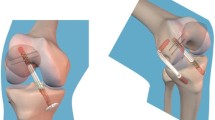Abstract
Purpose
This study evaluated knee laxity in anterior tibial translation and rotation following removal of anterior cruciate ligament (ACL) remnants using a computer navigation system.
Methods
This prospective study included 50 knees undergoing primary ACL reconstruction using a navigation system. ACL remnants were classified into four morphologic types: Type 1, bridging between the roof of the intercondylar notch and tibia; Type 2, bridging between the posterior cruciate ligament and tibia; Type 3, bridging between the anatomical insertions of the ACL on the lateral wall of the femoral condyle and the tibia; and Type 4, no bridging of ACL remnants. Anterior tibial translation and rotatory laxity were measured before and after remnant resection using a navigation system at 30°, 60°, and 90° of knee flexion. The amount of change in anterior tibial translation and rotatory laxity of each type was compared among the types.
Results
The different morphologic types of ACL remnants were as follows: Type 1, 15 knees; Type 2, 9 knees; Type 3, 6 knees; and Type 4, 20 knees. The amount of change in anterior tibial translation and rotatory laxity at 30° knee flexion in Type 3 was significantly larger than in the other types. There were no significant differences in either tibial translation or rotatory laxity at 60° and 90° knee flexion among the types.
Conclusions
In Type 3, ACL remnants contributed to anteroposterior and rotatory knee laxity evaluated at 30° knee flexion. The bridging point of the remnants is important to knee laxity. The Type 3 remnant should be preserved as much as possible when ACL reconstruction surgery is performed.
Level of evidence
Prognostic study, Level II.



Similar content being viewed by others
References
Adachi N, Ochi M, Uchio Y, Sumen Y (2000) Anterior cruciate ligament augmentation under arthroscopy. A minimum 2-year follow-up in 40 patients. Arch Orthop Trauma Surg 120:128–133
Adachi N, Ochi M, Uchino Y, Iwasa J, Ryoke K, Kuriwaka M (2002) Contribution of mechanoreceptors in the anterior cruciate ligament to the joint position sense knee. Acta Orthop Scand 73:330–334
Borbon CA, Mouzopoulos G, Siebold R (2012) Why perform an ACL augmentation? Knee Surg Sports Traumatol Arthrosc 20:245–251
Bray R, Leonard C, Salo P (2002) Vascular physiology and longterm healing of partial ligament tears. J Orthop Res 20:984–989
Buoncristiani AM, Tjoumakaris FP, Starman JS, Ferretti M, Fu FH (2006) Anatomic double-bundle anterior cruciate ligament reconstruction. Arthroscopy 22:1000–1006
Colombet P, Robinson J, Christel P, Franceschi JP, Djian P (2007) Using navigation to measure rotation kinematics during ACL reconstruction. Clin Orthop Relat Res 454:59–65
Crain EH, Fithian DC, Paxton EW, Luetzow WF (2005) Variation in anterior cruciate ligament scar pattern: does the scar pattern affect anterior laxity in anterior cruciate ligament-deficient knees? Arthroscopy 21:19–24
Georgoulis A, Pappa L, Moebius U et al (2001) The presence of proprioceptive mechanoreceptors in the remnants of the ruptured ACL as a possible source of re-innervation of the ACL autograft. Knee Surg Sports Traumatol Arthrosc 9:364–368
Gohil S, Annear PO, Breidahl W (2007) Anterior cruciate ligament reconstruction using autologous double hamstrings: a comparison of standard versus minimal debridement techniques using MRI to assess revascurisation. J Bone Joint Surg Br 89:1165–1171
Hart R, Krejzla J, Svab P, Kocis J, Stipcak V (2008) Outcomes after conventional versus computer-navigated anterior cruciate ligament reconstruction. Arthroscopy 24:569–578
Hofbauer M, Valentin P, Kdolsky R, Ostermann RC, Graf A, Figl M, Aldrian S (2010) Rotational and translational laxity after computer-navigated single- and double\bundle anterior cruciate ligament reconstruction. Knee Surg Sports Traumatol Arthrosc 18:1201–1207
Ishibashi Y, Tsuda E, Tazawa K, Sato H, Toh S (2005) Intraoperative evaluation of the anatomical double-bundle anterior cruciate ligament reconstruction with the orthopilot navigation system. Orthopedics 28:s1277–s1282
Lee S, Kim H, Jang J, Seong SC, Lee MC (2012) Comparison of anterior and rotatory laxity using navigation between single- and double-bundle ACL reconstruction: prospective randomized trial. Knee Surg Sports Traumatol Arthrosc 20:752–761
Lopomo N, Zaffagnini S, Bignozzi S, Visani A, Marcacci M (2010) Pivot-shift test: analysis and quantification of knee laxity parameters using a navigation system. J Orthop Res 28:164–169
Maeda S, Ishibashi Y, Tsuda E, Yamamoto Y, Toh S (2011) Intraoperative navigation evaluation of tibial translation after resection of anterior cruciate ligament remnants. Arthroscopy 27:1203–1210
Monaco E, Labianca L, Conteduca F, De Carli A, Ferretti A (2007) Double bundle or single bundle plus extraarticular tenodesis in ACL reconstruction? A CAOS study. Knee Surg Sports Traumatol Arthros 15:1168–1174
Nakamae A, Ochi M, Deie M, Adachi N, Kanaya A, Nishimori M, Nakasa T (2010) Biomechanical function of anterior cruciate ligament remnants: how long do they contribute to knee stability after injury in patients with complete tears? Arthroscopy 26:1577–1585
Muneta T, Koga H, Ju YJ, Horie M, Nakamura T, Sekiya I (2012) Remnant volume of anterior cruciate ligament correlates preoperative patient’s status and postoperative outcome. Knee Surg Sports Traumatol Arthrosc. doi:10.1007/s00167-012-2023-5
Noyes FR, Bassett RW, Grood ES (1980) Arthroscopy in acute traumatic hemarthrosis of the knee. Incidence of anterior cruciate tears and other injuries. J Bone Joint Surg Am 62(687–695):757
Ochi M, Iwasa J, Uchino Y, Adachi N, Kawasaki K (2002) Induction of somatosensory evoked potentials by mechanical stimulation in reconstructed human anterior cruciate ligaments. J Bone Joint Surg Br 84:761–766
Robinson J, Carrat L, Granchi C, Colombet P (2007) Influence of anterior cruciate ligament bundles on knee kinematics: clinical assessment using computer-assisted navigation. Am J Sports Med 35:2006–2013
Siebold R, Fu F (2008) Assessment and augmentation of symptomatic anteromedial or posterolateral bundle tears of the anterior cruciate ligament. Arthroscopy 24:1289–1298
Tsuda E, Ishibashi Y, Fukuda A, Tsukada H, Toh S (2007) Validation of computer-assisted double-bundle anterior cruciate ligament reconstruction. Orthopedics 30:S136–S140
Author information
Authors and Affiliations
Corresponding author
Rights and permissions
About this article
Cite this article
Nakase, J., Toratani, T., Kosaka, M. et al. Roles of ACL remnants in knee stability. Knee Surg Sports Traumatol Arthrosc 21, 2101–2106 (2013). https://doi.org/10.1007/s00167-012-2260-7
Received:
Accepted:
Published:
Issue Date:
DOI: https://doi.org/10.1007/s00167-012-2260-7




